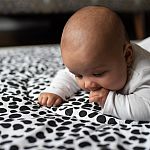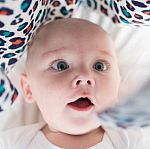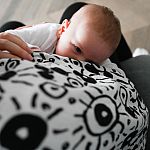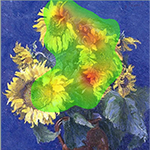Research findings
Our aim is that our research will have a positive impact on the lives of babies and their families. We work closely with companies, organisations and charities, applying our findings to real-world challenges. Specifically, we aim to inform the design of products, books, drama and art for babies so that it is optimised for how they see, think and learn. We also aim to improve how babies experience and access the arts and heritage. See below for some of our applied collaborations.
Baby product design
 The Sussex Baby Lab has had scientific partnerships with companies such as Cosatto Ltd and Etta Loves, feeding our research findings on infant perception into their product design. For example, we conducted studies on infant pattern perception to inform Etta Loves’ designs, including a design by the artist Camille Walala.
The Sussex Baby Lab has had scientific partnerships with companies such as Cosatto Ltd and Etta Loves, feeding our research findings on infant perception into their product design. For example, we conducted studies on infant pattern perception to inform Etta Loves’ designs, including a design by the artist Camille Walala.



Baby books
Sussex Baby Lab research on how babies see colour, detail and shape has informed the design of baby books, including ‘Look, Touch Learn’ published by Child’s Play. Look, Touch, Learn: Sky was chosen as a Scottish Book Trust Book Bug book and as part of that scheme was given out to all babies born in Scotland in 2024/2025. Prof Franklin from the Sussex Baby Lab has also authored her own series of baby books which are designed to tap various visual skills which emerge in the first year of life. The Sussex Baby Lab have written blogs and given webinars for Book Trust and Scottish Book Trust on how to choose books for babies given their immature vision.
Baby drama
Sussex Baby Lab research has informed the design of three professional drama shows for babies: First Light by Daniel Nadaffy and Marty Langthorne, which recently showed at the Barbican; Kaleidoscope by Filskit Theatre; and the award winning Glow by Flying Eye which toured internationally.
Babies in museums
 Sussex Baby Lab research finds that certain art and visual exhibits draws the eye of babies. We are currently investigating how babies can benefit from visits to museums and galleries, and are conducting research at the Fitzwilliam Museum and Brighton and Hove Museums with babies. With funding from an Arts and Humanities Research Council Impact Acceleration grant, we have developed a resource with the charity Kids in Museums to help museums and galleries welcome and provide for babies.
Sussex Baby Lab research finds that certain art and visual exhibits draws the eye of babies. We are currently investigating how babies can benefit from visits to museums and galleries, and are conducting research at the Fitzwilliam Museum and Brighton and Hove Museums with babies. With funding from an Arts and Humanities Research Council Impact Acceleration grant, we have developed a resource with the charity Kids in Museums to help museums and galleries welcome and provide for babies.
Baby sensory
Sussex Baby Lab findings on infant vision and image perception have informed the development of baby sensory flash cards for the educational online publisher Twinkl. Our research also fed into the development of a baby sensory film by Etta Loves which has over 100K views on YouTube.
Support for colour vision divergent children
 Colour vision divergence (colour blindness) affects around one child in every classroom. However, children are no longer routinely tested for the condition in schools. We have developed and evaluated an child-friendly app, ColourSpot, which accurately tests for the condition in children as young as 4 and which provides guidance for teachers and parents on how to support the child. We are currently obtaining regulatory approval for the app so it can be used by parents, teachers and opticians. Our research has also identified that the design of many educational materials put children who are colour vision divergent at a disadvantage and we are working with educational publishers to help them adopt inclusive design.
Colour vision divergence (colour blindness) affects around one child in every classroom. However, children are no longer routinely tested for the condition in schools. We have developed and evaluated an child-friendly app, ColourSpot, which accurately tests for the condition in children as young as 4 and which provides guidance for teachers and parents on how to support the child. We are currently obtaining regulatory approval for the app so it can be used by parents, teachers and opticians. Our research has also identified that the design of many educational materials put children who are colour vision divergent at a disadvantage and we are working with educational publishers to help them adopt inclusive design.
British Science Festival Baby Art Gallery
In collaboration with the British Science Festival 2017, the Sussex Baby Lab curated a Baby Art Gallery combining art and science. Using eye-tracking, we recorded baby's eye movements when shown different artworks. We formulated this on a heatmap which was superimposed on top of the original art to show what babies were interested in looking at.
For those who missed the Baby Art Gallery, we have made a highlight video of the event.
A special report about our event was also reported on BBC News. Check out the video below.
- Scientific Publications
- 2025
-
McAdams, P., Svobodova, S., Newman, T. J., Terry, K., Mather, G., Skelton, A. E., & Franklin, A. (2025). The edge orientation entropy of natural scenes is associated with infant visual preferences and adult aesthetic judgements. PloS one, 20(2), e0316555.
- 2023
-
McAdams, P., Chambers, M., Bosten, J. M., Skelton, A. E., & Franklin, A. (2023). Chromatic and spatial image statistics predict infants’ visual preferences and adults’ aesthetic preferences for art. Journal of Vision, 23(8), 2-2.
Skelton, A. E., Franklin, A., & Bosten, J. M. (2023). Colour vision is aligned with natural scene statistics at 4 months of age. Developmental Science, 26(6), e13402.
Maule, J., Skelton, A. E., & Franklin, A. (2023). The development of color perception and cognition. Annual Review of Psychology, 74(1), 87-111.
- 2022
-
Tang, T., Álvaro, L., Alvarez, J., Maule, J., Skelton, A., Franklin, A., & Bosten, J. (2022). ColourSpot, a novel gamified tablet-based test for accurate diagnosis of color vision deficiency in young children. Behavior Research Methods, 54(3), 1148-1160.
Bosten, J. M., Coen-Cagli, R., Franklin, A., Solomon, S. G., & Webster, M. A. (2022). Calibrating vision: Concepts and questions. Vision research, 201, 108131.
Skelton, A. E., Maule, J., & Franklin, A. (2022). Infant color perception: Insight into perceptual development. Child development perspectives, 16(2), 90-95.
- 2021
-
Witzel, C., Flack, Z., Sanchez-Walker, E., & Franklin, A. (2021). Colour category constancy and the development of colour naming. Vision Research, 187, 41-54.
- 2020
-
Rogers, M., Witzel, C., Rhodes, P., Franklin, A. (2020). Color constancy and color term knowledge are positively related during early childhood, Journal of Experimental Child Psychology, 196, 104825, https://doi.org/10.1016/j.jecp.2020.104825
Ludlow, A., Giannadou, A., Franklin, A., Allen, P., Simmons, D., Wilkins, A. (2020). The possible use of precision tinted lenses to improve social cognition in children with autism spectrum disorders. Vision Research. 170, 53-59. https://doi.org/10.1016/j.visres.2020.03.007
Skelton, A. & Franklin, A. (2020). Infants look longer at colours that adults like when colours are highly saturated, Psychonomic bulletin & review, 27, 78-85. https://doi.org/10.3758/s13423-019-01688-5
Rogers, M. R., Witzel, C., Rhodes, P., & Franklin, A. (2020). Color constancy and color term knowledge are positively related during early childhood. Journal of experimental child psychology, 196, 104825.
Skelton, A. E., & Franklin, A. (2020). Infants look longer at colours that adults like when colours are highly saturated. Psychonomic Bulletin & Review, 27(1), 78-85.
Ludlow, A. K., Giannadou, A., Franklin, A., Allen, P. M., Simmons, D. R., & Wilkins, A. J. (2020). The possible use of precision tinted lenses to improve social cognition in children with autism spectrum disorders. Vision Research, 170, 53-59.
- 2019
-
Maule, J. & Franklin, A. (2019). Color categorization in infants. Current Opinion in Behavioral Sciences, 30, 163-168. https://doi.org/10.1016/j.cobeha.2019.08.005
Bosten, J., Alvaro, L., Alvarez, J., Meyer, B., Tang, T., Maule, J. & Franklin, A. (2019). Tablet-based app for screening CVD in young children. Journal of Vision, 19(8), 71. https://doi.org/10.1167/19.8.71
- 2018
-
Cong, Y. Q., Junge, C., Aktar, E., Raijmakers, M., Franklin, A. & Sauter, D. (2018). Pre-verbal infants perceive emotional facial expressions categorically. Cognition and Emotion, 1-13. doi:10.1080/02699931.2018.1455640
Maule, J., Stanworth, K., Pellicano, E. & Franklin, A. (2018). Color afterimages in autistic adults. Journal of Autism and Developmental Disorders, 48(4), 1409-1421. doi:10.1007/s10803-016-2786-5
- 2017
-
Rothen, N., Bartl, G., Franklin, A., & Ward, J. (2017). Electrophysiological correlates and psychoacoustic characteristics of hearing-motion synaesthesia. Neuropsychologia, 106, 280-288. doi:10.1016/j.neuropsychologia.2017.08.031
Forder, L., Xun, H. & Franklin, A. (2017). Colour categories are reflected in sensory stages of colour perception when stimulus issues are resolved. PLoS ONE, 12(5). e0178097. doi:10.1371/journal.pone.0178097
Skelton, A.E., Catchpole, G., Abbott, J.T., Bosten, J.M. & Franklin, A. (2017). Biological origins of color categorization. Proceedings of the National Academy of Sciences of the United States of America, 114(21), 5545-5550. doi:10.1073/pnas.1612881114
Maule, J., Stanworth, K., Pellicano, E. & Franklin, A. (2017). Ensemble perception of colour in autistic adults. Autism Research, 10(5), 839-851. doi:10.1002/aur.1725
Forder, L., Bosten, J., He, X. & Franklin, A. (2017). A neural signature of the unique hues. Scientific Reports, 7. a42364. doi:10.1038/srep42364
- 2016
-
Forder, L., Taylor, O., Mankin, H., Scott, R.B. & Franklin, A. (2016). Colour terms affect detection of colour and colour-associated objects suppressed from visual awareness. PLoS ONE, 11(3). e0152212. doi:10.1371/journal.pone.0152212
Rogers, M., Knoblauch, K. & Franklin, A. (2016). Maximum likelihood conjoint measurement of lightness and chroma. Journal of the Optical Society of America, A, 33(3), A184-A193. doi:10.1364/JOSAA.33.00A184
Maule, J. & Franklin, A. (2016). Accurate rapid averaging of multihue ensembles is due to a limited capacity sub-sampling mechanism. Journal of the Optical Society of America, A, 33(3), A22-A29. doi:10.1364/JOSAA.33.000A22
Brooker, A. & Franklin, A. (2016). The effect of colour on children's cognitive performance. British Journal of Educational Psychology, 86(2), 241-255. doi:10.1111/bjep.12101
- 2015
-
Álvaro, L., Moreira, H., Lillo, J. & Franklin, A. (2015). Color preference in red-green dichromats. Proceedings of the National Academy of Sciences, 112(30), 9316-9321. doi:10.1073/pnas.1502104112
Maule, J. & Franklin, A. (2015). Effects of ensemble complexity and perceptual similarity on rapid averaging of hue. Journal of Vision, 15(6). doi:10.1167/15.4.6
Wright, O., Davies, I.R.L. & Franklin, A. (2015). Whorfian effects on colour memory are not reliable. The Quarterly Journal of Experimental Psychology, 68(4), 745-758. doi:10.1080/17470218.2014.966123
Elliot, A.J., Fairchild, M.D. & Franklin, A. (2015). Handbook of color psychology. Cambridge University Press.
Franklin, A. (2015). The development of color categorization. In Elliot, A.J., Fairchild, M.D & Franklin, A. (Eds.) Handbook of color psychology. Cambridge University Press, in press.
- 2014
-
Bird, C., Berens, S., Horner, A. & Franklin, A. (2014). Categorical encoding of color in the brain. Proceedings of the National Academy of Sciences, 111(12), 4590-4595. doi:10.1073/pnas.1315275111
Witzel, C. & Franklin, A. (2014). Do focal colors look particularly colorful? Journal of the Optical Society of America, 31(4), A365-A374. doi:10.1364/JOSAA.31.00A365
Xun, H., Witzel, C., Forder, L., Clifford, A. & Franklin, A. (2014.) Color categories only affect post-perceptual processes when same- and different-category colors are equally discriminable. Journal of the Optical Society of America, 31(4), A322-A331. doi:10.1364/JOSAA.31.00A322
Maule, J., Witzel C. & Franklin, A. (2014). Getting the gist of multiple hues: metric and categorical effects on ensemble perception of hue. Journal of the Optical Society of America, 31(4), A93-A102. doi:10.1364/JOSAA.31.000A93
Ludlow, A., Heaton, P., Hill, E. & Franklin, A. (2014). Colour obsessions and phobias in Autism Spectrum Disorders: the case of J.G. Neurocase, 20(3), 296-306. doi:10.1080/13554794.2013.770880
Franklin, A., Skelton, A. & Catchpole, G. (2014). The case for infant colour categories. Carole Biggam et al. (Eds). Progress in Colour Studies. John Benjamins Publishing Company.
Franklin, A. (2014). Infant hue categories. Chapter in: Ronier Luo (Ed.) Encyclopedia of Color Science and Technology. Springer.
- 2013
-
Bannisy, M.J., Tester, V., Muggleton, N.G., Janik, A.B., Davenport, A., Franklin, A., Walsh, V. & Ward, J. (2013). Synesthesia for color is linked to improved color perception, but reduced motion perception. Psychological Science, 24(12), 2390-2397. doi:10.1177/0956797613492424
Taylor, C., Clifford, A. & Franklin, A. (2013). Color preferences are not universal. Journal of Experimental Psychology: General, 142(4), 1015-1027. doi:10.1037/a0030273
Farran, E.K., Cranwell, M.K., Alvarez, J. & Franklin, A. (2013). Colour discrimination and categorisation in Williams syndrome. Research in Developmental Disabilities, 34(10), 3352-3360. doi:10.1016/j.ridd.2013.06.043
Taylor, C., Schloss, K., Palmer, S. & Franklin, A. (2013). Color preferences in infants and adults are different. Psychonomic Bulletin and Review, 20(5), 916-922. doi:10.3758/s13423-013-0411-6
- 2012
-
Clifford, A., Franklin, A., Holmes, A., Drivonikou, G.V., Ozgen, E., & Davies, I.R.L. (2012). Neural correlates of acquired color category effects. Brain and Cognition, 80, 126-143. doi:10.1016/j.bandc.2012.04.011
Taylor, C. & Franklin, A. (2012). The relationship between color-object associations and color preference: Further investigation of Ecological Valence Theory. Psychonomic Bulletin and Review, 19(2), 190-197. doi:10.3758/s13423-012-0222-1
Franklin, A., Gibbons, E., Chittenden, K, Alvarez, J. & Taylor, C. (2012). Infant color preference for red is not selectively context specific. Emotion, 12(5), 1155-1160. doi:10.1037/a0025333
- 2011
-
Franklin, A. & Sowden, P. (2011). Colour in Autism Spectrum Disorders. In Biggam, Carole P., Hough, Carole, Kay, Christian & Simmons, David R.C. (Eds.), New Directions in Colour Studies. John Benjamins, Amsterdam, NL.
Drivonikou, G.V., Clifford, A., Franklin, A. & Davies, I.R.L. (2011). Category training affects colour discrimination but only in the right visual field. In Biggam et al. (Eds.), New Directions in Colour Studies. John Benjamins, Amsterdam, NL.
Clifford, A., Franklin, A., Holmes, A. & Davies, I.R.L. (2011). Investigating the underlying mechanisms of categorical perception of colour using the Event-Related Potential technique. In Biggam et al. (Eds.), New Directions in Colour Studies. John Benjamins, Amsterdam, NL.
- 2010
-
Clifford, A., Holmes, A., Davies, I.R.L. & Franklin, A. (2010). Color categories affect pre-attentive color perception. Biological Psychology, 85(2), 275-282. doi:10.1016/j.biopsycho.2010.07.014
Franklin, A., Catherwood, D., Alvarez, J. & Axelsson, E. (2010). Hemispheric asymmetries in categorical perception of orientation in infants and adults. Neuropsychologia, 48(9), 2648-57. doi:10.1016/j.neuropsychologia.2010.05.011
Franklin, A., Sowden, P., Notman, L., Gonzales-Dixon, M., West, D., Alexander, I., Loveday, S. & White, A. (2010). Reduced chromatic discrimination in children with Autism Spectrum Disorders. Developmental Science, 13, 188-200. doi:10.1111/j.1467-7687.2009.00869.x
Franklin, A., Bevis, L., Ling, Y. & Hurlbert, A. (2010). Biological components of infant colour preference. Developmental Science, 13(2), 346-354. doi:10.1111/j.1467-7687.2009.00884.x
- 2009
-
Franklin, A. (2009). Pre-linguistic categorical perception of colour cannot be explained by colour preference: response to Roberson and Hanley. Trends in Cognitive Sciences, 13(12), 501-502. doi:10.1016/j.tics.2009.10.006
Clifford, A., Franklin, A., Davies, I.R.L. & Holmes, A. (2009). Electrophysiological markers of categorical perception of color in 7-month old infants. Brain and Cognition, 71(2), 165-172. doi:10.1016/j.bandc.2009.05.002
Holmes, A., Franklin, A., Clifford, A. & Davies, I.R.L. (2009). Neurophysiological evidence for categorical perception of colour. Brain and Cognition, 69(2), 426-434. doi:10.1016/j.bandc.2008.09.003
Franklin, A., Wright, O. & Davies, I.R.L. (2009). What can we learn from toddlers about categorical perception of colour? Comments on Goldstein, Davidoff, and Roberson. Journal of Experimental Child Psychology, 102(2), 239-245. doi:10.1016/j.jecp.2008.08.003
Overview of Franklin, Drivonikou, Clifford et al. in ‘Editor’s Choice’ section of Science: Chin, G. (2009). ‘Reading from left to right.’ Science, 322, 1610.
- 2008
-
Franklin, A., Drivonikou, G.V., Clifford, A., Kay, P., Regier, T. & Davies, I.R.L. (2008). Lateralization of categorical perception of color changes with color term acquisition. Proceedings of the National Academy of Sciences, USA, 105(47), 18221-18225. doi:10.1073/pnas.0809952105
Franklin, A., Sowden, P., Burley, R., Notman, L. & Alder, E. (2008). Colour perception in children with autism. Journal of Autism and Developmental Disorders, 38(10), 1837-47. doi:10.1007/s10803-008-0574-6
Franklin, A., Pitchford, N.J.P., Mahony, L., Davies, I.R.L., Clausse, S. & Jennings, S. (2008). Salience of primary and secondary colours in infancy. British Journal of Developmental Psychology, 26(4), 471-483. doi:10.1348/026151007X256672
Franklin, A., Drivonikou, G.V., Bevis, L., Davies, I.R.L., Kay, P. & Regier, T. (2008). Categorical perception of color is lateralized to the right hemisphere in infants, but to the left hemisphere in adults. Proceedings of the National Academy of Sciences, USA, 105(9), 3221-3225. doi:
- 2007 and pre-2006
-
Drivonikou, G.V., Kay, P., Regier, T., Ivry, R., Gilbert, A., Franklin, A. & Davies, I.R.L. (2007). Further evidence of Whorfian effects to the right visual field. Proceedings of the National Academy of Sciences, USA, 104(3), 1097-1102. doi:10.1073/pnas.0610132104
Franklin, A., & Davies, I.R.L. (2006). Converging evidence for pre-linguistic colour categorisation. In C.P Biggam & N. Pitchford (Eds.), Progress in Colour Studies: Psychological Aspects (pp. 101-120). John Benjamins: Amsterdam, NL.
Franklin, A., (2006). Constraints on children’s colour term acquisition. Journal of Experimental Child Psychology, 94(4), 322-327. doi:10.1016/j.jecp.2006.02.003
Daoutis, C., Franklin, A., Riddett, A., Clifford, C. & Davies, I.R.L. (2006). Categorical effects in children’s colour search: a cross-linguistic comparison. British Journal of Developmental Psychology, 24(2), 373-400. doi:0.1348/026151005X51266
Franklin, A., Pilling, M. & Davies, I.R.L. (2005). The nature of infant colour categorisation: Evidence from eye-movements on a target detection task. Journal of Experimental Child Psychology, 91(3), 227-248. doi:https://doi.org/10.1016/j.jecp.2005.03.003
Franklin, A., Clifford, A., Williamson, E. & Davies, I.R.L. (2005). Colour term knowledge does not affect categorical perception of colour in toddlers. Journal of Experimental Child Psychology, 90(2), 114-141. doi:10.1016/j.jecp.2004.10.001
Franklin, A. & Davies, I.R.L. (2004). New evidence for infant colour categories. British Journal of Developmental Psychology, 22(3), 349-377. doi:10.1348/0261510041552738
Davies, I.R.L. & Franklin, A. (2002). Categorical similarity may affect colour pop-out in infants after-all. British Journal of Developmental Psychology, 20(2), 185-203. doi:10.1348/026151002166406
- Media
-
- The Times, Baroque or Brutalist? Babies like buildings with bells and whistles, March 2025
- The Daily Telegraph, Modern architecture is an eye-sore , even babies can see that, March 2025
- BBC Sussex, Babies prefer complex architecture, study suggests, March 2025
- The Guardian, Art is a natural impulse, and babies are born critics, August 2023
- The Guardian, Adults’ penchant for van Gogh is mirrored in babies, August 2023
- Wall Street Journal, Colourblindness exam gets a kid friendly makeover, May 2021
- The Telegraph, Coverage of ColourSpot, October 2021
- The Times Educational Supplement, How schools can help colourblind pupils, September 2021
- Scientific American, Are Colors Innate or Learned?, 12 Jul 2017
- IFL Science, Babies can categorise different colours, suggesting it's hardwired into us, 9 May 2017
- Medical XPress, Study with infants suggests color categorization is biological, 9 May 2017
- ZME Science, Biology imparts us with instinctive color categories — culture only shapes them, 9 May 2017
- Axios, We're born knowing colours, 9 May 2017
- The Guardian, How we categorise colour is based on biology, not culture, study suggests, 8 May 2017
- Live Science,Babies Can Sort Colors Before They Learn the Words for Them, 8 May 2017
- Vozpopuli,Un estudio con bebés pretende zanjar la polémica sobre la percepción del color, 8 May 2017
- ScienceMag, Babies' gaze suggests we are born understanding colour , 8 May 2017
- The Guardian,The vision thing: how babies colour in the world, 11 Apr 2017
- The Guardian,Science Weekly Podcast, First impressions: what can babies see?, 1 Apr 2017
- ITV News, Do you know what your child is thinking? 15 Feb 2017
- Horizon2020, How we perceive colour depends on our culture and language, 15 Nov 2016
- The British Psychological Society, Colourful Language, 20 Jun 2016
- Nautilus, Why Red Means Red in Almost Every Language, 30 Jul 2015
- The Guardian, Is The Dress blue and black or white and gold? The answer lies in vision psychology, 27 Feb 2015
- ScienceNews, Brain uses decision-making region to tell blue from green, 4 Mar 2014
- BBC World, The Why Factor: Blue, 19 Nov 2012
Photo credits – Header image, Shutterstock, Etta Loves logo and baby images, Etta Loves, Sunflowers, Brighton Museums, Colourspot logo, The Colour Group.
